Is Dialdehyde Chitosan a Good Substance to Modify Physicochemical Properties of Biopolymeric Materials?
Abstract
1. Introduction
2. Results and Discussion
2.1. Characterization of Dialdehyde Chitosan
2.2. FTIR-ATR Scaffold Characterization
2.3. Swelling Behavior in Phosphate-Buffered Saline (PBS) and Water Content
2.4. Porosity and Density
2.5. Scanning Electron Microscopy
2.6. Mechanical Properties
2.7. Thermal Properties
2.8. Cytotoxicity and Cell Attachment
3. Materials and Methods
3.1. Fabrication of Dialdehyde Chitosan
3.2. Fabrication of Scaffolds
3.3. Characterization of Dialdehyde Chitosan
- C1—the concentration of NaOH solution [mol/dm3],
- V1—the volume of NaOH solution [dm3],
- C2—the concentration of HCl solution [mol/dm3],
- V2—the volume of HCl solution [dm3],
- m—mass of the sample [g],
- M—molecular weight of the repeated unit in dialdehyde chitosan [M = 160g/mol].
3.4. Fourier Transform Infrared Spectroscopy (FTIR)
3.5. Swelling Behavior in Phosphate-Buffered Saline (PBS) and Water Content
- ms(t) is the weight of the material after immersion in PBS [g],
- ms(0) is the weight of the material before immersion [g].
3.6. Porosity and Density
- V1—initial volume of isopropanol [cm3],
- V2—total volume of isopropanol with the isopropanol impregnated sample [cm3],
- V3—volume of isopropanol after scaffold removal [cm3].
- W—weight of sample [mg],
- V2, V3—as above.
3.7. Scanning Electron Microscopy
3.8. Mechanical Properties
3.9. Thermal Properties
3.10. Cell Seeding on Composite Scaffolds
3.11. Metabolic Activity and Cells Attachment
- Sx—fluorescence of the samples,
- Scontrol—fluorescence of EMEM with 5% AlamarBlue reagent, without cells (0% reduction of resazurin),
- S100%reduced—fluorescence of EMEM with 5% AlamarBlue reagent autoclaved at 121 °C for 15 min (100% reduction of resazurin).
4. Conclusions
Author Contributions
Funding
Institutional Review Board Statement
Informed Consent Statement
Data Availability Statement
Acknowledgments
Conflicts of Interest
References
- Reddy, N.; Reddy, R.; Jiang, Q. Crosslinking biopolymers for biomedical applications. Trends Biotechnol. 2015, 33, 362–369. [Google Scholar] [CrossRef]
- Thakur, G.; Rodrigues, F.C.; Singh, K. Crosslinking biopolymers for advanced drug delivery and tissue engineering applications. In Cutting-Edge Enabling Technologies for Regenerative Medicine; Chun, H.J., Park, C.H., Kwon, I.K., Khang, G., Eds.; Advances in Experimental Medicine and Biology; Springer: Singapore, 2018; pp. 213–231. ISBN 9789811309502. [Google Scholar]
- Buckley, C.T.; Vinardell, T.; Thorpe, S.D.; Haugh, M.G.; Jones, E.; McGonagle, D.; Kelly, D.J. Functional properties of cartilaginous tissues engineered from infrapatellar fat pad-derived mesenchymal stem cells. J. Biomech. 2010, 43, 920–926. [Google Scholar] [CrossRef] [PubMed]
- Yang, L. Tissue Engineered cartilage generated from human trachea using DegraPol® scaffold. Eur. J. Cardio Thorac. 2003, 24, 201–207. [Google Scholar] [CrossRef][Green Version]
- Skopinska-Wisniewska, J.; Wegrzynowska-Drzymalska, K.; Bajek, A.; Maj, M.; Sionkowska, A. Is dialdehyde starch a valuable cross-linking agent for collagen/elastin based materials? J. Mater. Sci. Mater. Med. 2016, 27, 67. [Google Scholar] [CrossRef]
- Johari, N.; Moroni, L.; Samadikuchaksaraei, A. Tuning the conformation and mechanical properties of silk fibroin hydrogels. Eur. Polym. J. 2020, 134, 109842. [Google Scholar] [CrossRef]
- Dmour, I.; Taha, M. Natural and semisynthetic polymers in pharmaceutical nanotechnology. In Organic Materials as Smart Nanocarriers for Drug Delivery; Elsevier Inc.: Cambridge, MA, USA, 2018; ISBN 978-0-12-813663-8. [Google Scholar]
- Chiono, V.; Pulieri, E.; Vozzi, G.; Ciardelli, G.; Ahluwalia, A.; Giusti, P. Genipin-crosslinked chitosan/gelatin blends for biomedical applications. J. Mater. Sci. Mater. Med. 2008, 19, 889–898. [Google Scholar] [CrossRef] [PubMed]
- Grabska-Zielińska, S.; Sionkowska, A.; Reczyńska, K.; Pamuła, E. Physico-chemical characterization and biological tests of collagen/silk fibroin/chitosan scaffolds cross-linked by dialdehyde starch. Polymers 2020, 12, 372. [Google Scholar] [CrossRef] [PubMed]
- Spanneberg, R.; Schymanski, D.; Stechmann, H.; Figura, L.; Glomb, M.A. Glyoxal modification of gelatin leads to change in properties of solutions and resulting films. Soft. Matter. 2012, 8, 2222–2229. [Google Scholar] [CrossRef]
- Zhou, H.; Wang, Z.; Cao, H.; Hu, H.; Luo, Z.; Yang, X.; Cui, M.; Zhou, L. Genipin-crosslinked polyvinyl alcohol/silk fibroin/nano-hydroxyapatite hydrogel for fabrication of artificial cornea scaffolds-a novel approach to corneal tissue engineering. J. Biomater. Sci. Polym. Ed. 2019, 30, 1604–1619. [Google Scholar] [CrossRef]
- Du, T.; Chen, Z.; Li, H.; Tang, X.; Li, Z.; Guan, J.; Liu, C.; Du, Z.; Wu, J. Modification of collagen–chitosan matrix by the natural crosslinker alginate dialdehyde. Int. J. Biol. Macromol. 2016, 82, 580–588. [Google Scholar] [CrossRef]
- Skopinska-Wisniewska, J.; Kuderko, J.; Bajek, A.; Maj, M.; Sionkowska, A.; Ziegler-Borowska, M. Collagen/elastin hydrogels cross-linked by squaric acid. Mat. Sci. Eng. C 2016, 60, 100–108. [Google Scholar] [CrossRef] [PubMed]
- Rinaudo, M. Main properties and current applications of some polysaccharides as biomaterials. Polym. Int. 2008, 57, 397–430. [Google Scholar] [CrossRef]
- Dutta, P.K.; Dutta, J.; Tripathi, V.S. Chitin and chitosan: Chemistry, properties and applications. J. Sci. Ind. Res. India. 2004, 63, 20–31. [Google Scholar]
- Chen, F.; Wang, Z.-C.; Lin, C.-J. Preparation and characterization of nano-sized hydroxyapatite particles and hydroxyapatite/chitosan nano-composite for use in biomedical materials. Mater. Lett. 2002, 57, 858–861. [Google Scholar] [CrossRef]
- Lewandowska, K. Surface Studies of microcrystalline chitosan/poly(Vinyl Alcohol) mixtures. Appl. Surf. Sci. 2012, 263, 115–123. [Google Scholar] [CrossRef]
- Lewandowska, K. Viscometric Studies in dilute solution mixtures of chitosan and microcrystalline chitosan with poly(Vinyl Alcohol). J. Solut. Chem. 2013, 42, 1654–1662. [Google Scholar] [CrossRef]
- Lewandowska, K.; Sionkowska, A.; Grabska, S. Chitosan blends containing hyaluronic acid and collagen. Compatibility behaviour. J. Mol. Liq. 2015, 212, 879–884. [Google Scholar] [CrossRef]
- Palma, P.J.; Ramos, J.C.; Martins, J.B.; Diogenes, A.; Figueiredo, M.H.; Ferreira, P.; Viegas, C.; Santos, J.M. Histologic evaluation of regenerative endodontic procedures with the use of chitosan scaffolds in immature dog teeth with apical periodontitis. J. Endod. 2017, 43, 1279–1287. [Google Scholar] [CrossRef] [PubMed]
- Huang, Y.-M.; Lin, Y.-C.; Chen, C.-Y.; Hsieh, Y.-Y.; Liaw, C.-K.; Huang, S.-W.; Tsuang, Y.-H.; Chen, C.-H.; Lin, F.-H. Thermosensitive chitosan–gelatin–glycerol phosphate hydrogels as collagenase carrier for tendon–bone healing in a rabbit model. Polymers 2020, 12, 436. [Google Scholar] [CrossRef]
- Koide, S.S. Chitin-chitosan: Properties, benefits and risks. Nutr. Res. 1998, 18, 1091–1101. [Google Scholar] [CrossRef]
- Oyatogun, G.M.; Esan, T.A.; Akpan, E.I.; Adeosun, S.O.; Popoola, A.P.I.; Imasogie, B.I.; Soboyejo, W.O.; Afonja, A.A.; Ibitoye, S.A.; Abere, V.D.; et al. Chitin, chitosan, marine to market. In Handbook of Chitin and Chitosan; Gopi, S., Thomas, S., Pius, A., Eds.; Elsevier: Amsterdam, The Netherlands, 2020; pp. 335–376. ISBN 978-0-12-817970-3. [Google Scholar]
- Sionkowska, A. Current research on the blends of natural and synthetic polymers as new biomaterials: Review. Prog. Polym. Sci. 2011, 36, 1254–1276. [Google Scholar] [CrossRef]
- Vold, I.M.N.; Christensen, B.E. Periodate oxidation of chitosans with different chemical compositions. Carbohydr. Res. 2005, 340, 679–684. [Google Scholar] [CrossRef] [PubMed]
- Hu, Y.; Liu, L.; Gu, Z.; Dan, W.; Dan, N.; Yu, X. Modification of collagen with a natural derived cross-linker, alginate dialdehyde. Carbohydr. Polym. 2014, 102, 324–332. [Google Scholar] [CrossRef]
- Liu, X.; Dan, N.; Dan, W.; Gong, J. Feasibility study of the natural derived chitosan dialdehyde for chemical modification of collagen. Int. J. Biol. Macromol. 2016, 82, 989–997. [Google Scholar] [CrossRef]
- He, X.; Tao, R.; Zhou, T.; Wang, C.; Xie, K. Structure and properties of cotton fabrics treated with functionalized dialdehyde chitosan. Carbohydr. Polym. 2014, 103, 558–565. [Google Scholar] [CrossRef]
- Wegrzynowska-Drzymalska, K.; Grebicka, P.; Mlynarczyk, D.T.; Chelminiak-Dudkiewicz, D.; Kaczmarek, H.; Goslinski, T.; Ziegler-Borowska, M. Crosslinking of chitosan with dialdehyde chitosan as a new approach for biomedical applications. Materials 2020, 13, 3413. [Google Scholar] [CrossRef] [PubMed]
- Keshk, S.M.; Ramadan, A.M.; Al-Sehemi, A.G.; Irfan, A.; Bondock, S. An unexpected reactivity during periodate oxidation of chitosan and the affinity of its 2, 3-Di-Aldehyde toward sulfa drugs. Carbohydr. Polym. 2017, 175, 565–574. [Google Scholar] [CrossRef]
- Lv, Y.; Long, Z.; Song, C.; Dai, L.; He, H.; Wang, P. Preparation of dialdehyde chitosan and its application in green synthesis of silver nanoparticles. Bioresources 2013, 8, 6161–6172. [Google Scholar] [CrossRef]
- Wang, X.; Gu, Z.; Qin, H.; Li, L.; Yang, X.; Yu, X. Crosslinking effect of dialdehyde starch (DAS) on decellularized porcine aortas for tissue engineering. Int. J. Biol. Macromol. 2015, 79, 813–821. [Google Scholar] [CrossRef] [PubMed]
- Kaczmarek, B.; Sionkowska, A.; Monteiro, F.J.; Carvalho, A.; Łukowicz, K.; Osyczka, A.M. Characterization of gelatin and chitosan scaffolds cross-linked by addition of dialdehyde starch. Biomed. Mater. 2017, 13, 015016. [Google Scholar] [CrossRef]
- Sarker, B.; Papageorgiou, D.G.; Silva, R.; Zehnder, T.; Gul-E-Noor, F.; Bertmer, M.; Kaschta, J.; Chrissafis, K.; Detsch, R.; Boccaccini, A.R. Fabrication of alginate–gelatin crosslinked hydrogel microcapsules and evaluation of the microstructure and physico-chemical properties. J. Mater. Chem. B 2014, 2, 1470. [Google Scholar] [CrossRef] [PubMed]
- Xu, Y.; Li, L.; Yu, X.; Gu, Z.; Zhang, X. Feasibility study of a novel crosslinking reagent (Alginate Dialdehyde) for biological tissue fixation. Carbohydr. Polym. 2012, 87, 1589–1595. [Google Scholar] [CrossRef]
- Tang, R.; Du, Y.; Fan, L. Dialdehyde starch-crosslinked chitosan films and their antimicrobial effects. J. Polym. Sci. B Polym. Phys. 2003, 41, 993–997. [Google Scholar] [CrossRef]
- Ziegler-Borowska, M.; Wegrzynowska-Drzymalska, K.; Chelminiak-Dudkiewicz, D.; Kowalonek, J.; Kaczmarek, H. Photochemical reactions in dialdehyde starch. Molecules 2018, 23, 3358. [Google Scholar] [CrossRef]
- Sionkowska, A.; Kozłowska, J. Properties and modification of porous 3-D collagen/hydroxyapatite composites. Int. J. Biol. Macromol. 2013, 52, 250–259. [Google Scholar] [CrossRef] [PubMed]
- Kuchaiyaphum, P.; Chotichayapong, C.; Butwong, N.; Bua-ngern, W. Silk fibroin/poly (Vinyl Alcohol) hydrogel cross-linked with dialdehyde starch for wound dressing applications. Macromol. Res. 2020, 28, 844–850. [Google Scholar] [CrossRef]
- Ahmed, S.; Ikram, S. Chitosan and gelatin based biodegradable packaging films with UV-light protection. J. Photoch. Photobio. B 2016, 163, 115–124. [Google Scholar] [CrossRef]
- Srinivasa, P.C.; Ramesh, M.N.; Kumar, K.R.; Tharanathan, R.N. Properties and sorption studies of chitosan–polyvinyl alcohol blend films. Carbohydr. Polym. 2003, 53, 431–438. [Google Scholar] [CrossRef]
- Revati, R.; Abdul Majid, M.S.; Ridzuan, M.J.M.; Normahira, M.; Mohd Nasir, N.F.; Rahman, Y.M.N.; Gibson, A.G. Mechanical, Thermal and morphological characterisation of 3D porous pennisetum purpureum/PLA biocomposites scaffold. Mat. Sci. Eng. C 2017, 75, 752–759. [Google Scholar] [CrossRef]
- Grabska-Zielińska, S.; Sionkowska, A.; Coelho, C.C.; Monteiro, F.J. Silk Fibroin/collagen/chitosan scaffolds cross-linked by a glyoxal solution as biomaterials toward bone tissue regeneration. Materials 2020, 13, 3433. [Google Scholar] [CrossRef] [PubMed]
- Kaczmarek, B.; Nadolna, K.; Owczarek, A. The physical and chemical properties of hydrogels based on natural polymers. In Hydrogels Based on Natural Polymers; Chen, Y., Ed.; Elsevier Ltd.: Amsterdam, The Netherlands, 2020; pp. 151–172. ISBN 978-0-12-816421-1. [Google Scholar]
- Karageorgiou, V.; Kaplan, D. Porosity of 3D biomaterial scaffolds and osteogenesis. Biomaterials 2005, 26, 5474–5491. [Google Scholar] [CrossRef]
- Kaczmarek, B.; Sionkowska, A.; Osyczka, A.M. The application of chitosan/collagen/hyaluronic acid sponge cross-linked by dialdehyde starch addition as a matrix for calcium phosphate in situ precipitation. Int. J. Biol. Macromol. 2018, 107, 470–477. [Google Scholar] [CrossRef] [PubMed]
- Yuan, L.; Li, X.; Ge, L.; Jia, X.; Lei, J.; Mu, C.; Li, D. Emulsion Template method for the fabrication of gelatin-based scaffold with a controllable pore structure. ACS Appl. Mater. Interfaces 2019, 11, 269–277. [Google Scholar] [CrossRef] [PubMed]
- Jiang, Y.; Zhou, J.; Yang, Z.; Liu, D.; Xv, X.; Zhao, G.; Shi, H.; Zhang, Q. Dialdehyde cellulose nanocrystal/gelatin hydrogel optimized for 3D printing applications. J. Mat. Sci. 2018, 53, 11883–11900. [Google Scholar] [CrossRef]
- Sionkowska, A.; Grabska, S. Preparation and characterization of 3D collagen materials with magnetic properties. Polym. Test. 2017, 62, 382–391. [Google Scholar] [CrossRef]
- Wang, J.; Sun, X.; Zhang, Z.; Wang, Y.; Huang, C.; Yang, C.; Liu, L.; Zhang, Q. Silk fibroin/collagen/hyaluronic acid scaffold incorporating pilose antler polypeptides microspheres for cartilage tissue engineering. Mater. Sci. Eng. C Mater. Biol. Appl. 2019, 94, 35–44. [Google Scholar] [CrossRef]
- Asadpour, S.; Kargozar, S.; Moradi, L.; Ai, A.; Nosrati, H.; Ai, J. Natural Biomacromolecule based composite scaffolds from silk fibroin, gelatin and chitosan toward tissue engineering applications. Int. J. Biol. Macromol. 2020, 154, 1285–1294. [Google Scholar] [CrossRef]
- Zhang, X.; Jia, C.; Qiao, X.; Liu, T.; Sun, K. Silk fibroin microfibers and chitosan modified poly (Glycerol Sebacate) Composite scaffolds for skin tissue engineering. Polym. Test. 2017, 62, 88–95. [Google Scholar] [CrossRef]
- Wang, Y.; Fan, S.; Li, Y.; Niu, C.; Li, X.; Guo, Y.; Zhang, J.; Shi, J.; Wang, X. Silk fibroin/sodium alginate composite porous materials with controllable degradation. Int. J. Biol. Macromol. 2020, 150, 1314–1322. [Google Scholar] [CrossRef]
- Lucas de Lima, E.; Fittipaldi Vasconcelos, N.; da Silva Maciel, J.; Karine Andrade, F.; Silveira Vieira, R.; Andrade Feitosa, J.P. Injectable hydrogel based on dialdehyde galactomannan and N-Succinyl chitosan: A suitable platform for cell culture. J. Mater. Sci. Mater. Med. 2019, 31, 5. [Google Scholar] [CrossRef]
- Skopinska-Wisniewska, J.; Tuszynska, M.; Olewnik-Kruszkowska, E. Comparative Study of gelatin hydrogels modified by various cross-linking agents. Materials 2021, 14, 396. [Google Scholar] [CrossRef] [PubMed]
- Lin, X.-L.; Gao, L.-L.; Li, R.; Cheng, W.; Zhang, C.-Q.; Zhang, X. Mechanical property and biocompatibility of silk fibroin–collagen type II composite membrane. Mat. Sci. Eng. C 2019, 105, 110018. [Google Scholar] [CrossRef]
- Singh, B.N.; Pramanik, K. Fabrication and evaluation of non-mulberry silk fibroin fiber reinforced chitosan based porous composite scaffold for cartilage tissue engineering. Tissue Cell 2018, 55, 83–90. [Google Scholar] [CrossRef] [PubMed]
- Hu, J.; Cai, X.; Mo, S.; Chen, L.; Shen, X.; Tong, H. Fabrication and characterization of chitosan-silk fibroin/hydroxyapatite composites via in situ precipitation for bone tissue engineering. Chin. J. Polym. Sci. 2015, 33, 1661–1671. [Google Scholar] [CrossRef]
- Lewandowska, K.; Sionkowska, A.; Grabska, S.; Michalska, M. Characterization of Chitosan/hyaluronic acid blend films modified by collagen. Prog. Chem. Appl. Chitin Deriv. 2017, 22, 125–134. [Google Scholar] [CrossRef]
- Lewandowska, K.; Furtos, G. Study of apatite layer formation on sbf-treated chitosan composite thin films. Polym. Test. 2018, 71, 173–181. [Google Scholar] [CrossRef]
- Lewandowska, K. Effect of an ionic liquid on the physicochemical properties of chitosan/poly(Vinyl Alcohol) mixtures. Int. J. Biol. Macromol. 2020, 147, 1156–1163. [Google Scholar] [CrossRef] [PubMed]
- Sharmila, G.; Muthukumaran, C.; Kirthika, S.; Keerthana, S.; Kumar, N.M.; Jeyanthi, J. Fabrication and characterization of spinacia oleracea extract incorporated alginate/carboxymethyl cellulose microporous scaffold for bone tissue engineering. Int. J. Biol. Macromol. 2020, 156, 430–437. [Google Scholar] [CrossRef] [PubMed]
- León-Mancilla, B.H.; Araiza-Téllez, M.A.; Flores-Flores, J.O.; Piña-Barba, M.C. Physico-chemical characterization of collagen scaffolds for tissue engineering. J. Appl. Res. Technol. 2016, 14, 77–85. [Google Scholar] [CrossRef]
- Zhang, K.-H.; Yu, Q.-Z.; Mo, X.-M. Fabrication and intermolecular interactions of silk fibroin/hydroxybutyl chitosan blended nanofibers. Int. J. Mol. Sci. 2011, 12, 2187–2199. [Google Scholar] [CrossRef]
- Parekh, N.; Hushye, C.; Warunkar, S.; Gupta, S.S.; Nisal, A. In vitro study of novel microparticle based silk fibroin scaffold with osteoblast-like cells for load-bearing osteo-regenerative applications. RSC Adv. 2017, 7, 26551–26558. [Google Scholar] [CrossRef]
- Rajalekshmi, R.; Kaladevi Shaji, A.; Joseph, R.; Bhatt, A. Scaffold for Liver tissue engineering: Exploring the Potential of fibrin incorporated alginate dialdehyde–gelatin hydrogel. Int. J. Biol. Macromol. 2021, 166, 999–1008. [Google Scholar] [CrossRef] [PubMed]
- Muchová, M.; Münster, L.; Capáková, Z.; Mikulcová, V.; Kuřitka, I.; Vícha, J. Design of dialdehyde cellulose crosslinked poly(Vinyl Alcohol) hydrogels for transdermal drug delivery and wound dressings. Mat. Sci. Eng. C 2020, 116, 111242. [Google Scholar] [CrossRef] [PubMed]
- Chen, Y.; Dan, N.; Huang, Y.; Yang, C.; Dan, W.; Liang, Y. Insights into the interactions between collagen and a naturally derived crosslinker, oxidized chitosan oligosaccharide. J. Appl. Polym. Sci. 2020, 137, 48489. [Google Scholar] [CrossRef]
- Bam, P.; Bhatta, A.; Krishnamoorthy, G. Design of biostable scaffold based on collagen crosslinked by dialdehyde chitosan with presence of gallic acid. Int. J. Biol. Macromol. 2019, 130, 836–844. [Google Scholar] [CrossRef] [PubMed]
- Sionkowska, A.; Grabska, S. Incorporation of magnetite particles in 3d matrices made from the blends of collagen, chitosan, and hyaluronic acid. Adv. Polym. Technol. 2018, 37, 2905–2914. [Google Scholar] [CrossRef]
- Lu, W.; Shen, Y.; Xie, A.; Zhang, W. Preparation and protein immobilization of magnetic dialdehyde starch nanoparticles. J. Phys. Chem. B 2013, 117, 3720–3725. [Google Scholar] [CrossRef]
- Krok-Borkowicz, M.; Filova, E.; Chlupac, J.; Klepetar, J.; Bacakova, L.; Pamuła, E. Influence of pore size and hydroxyapatite deposition in poly(L-Lactide-Co-Glycolide) scaffolds on osteoblast-like cells cultured in static and dynamic conditions. Mater. Lett. 2019, 241, 1–5. [Google Scholar] [CrossRef]
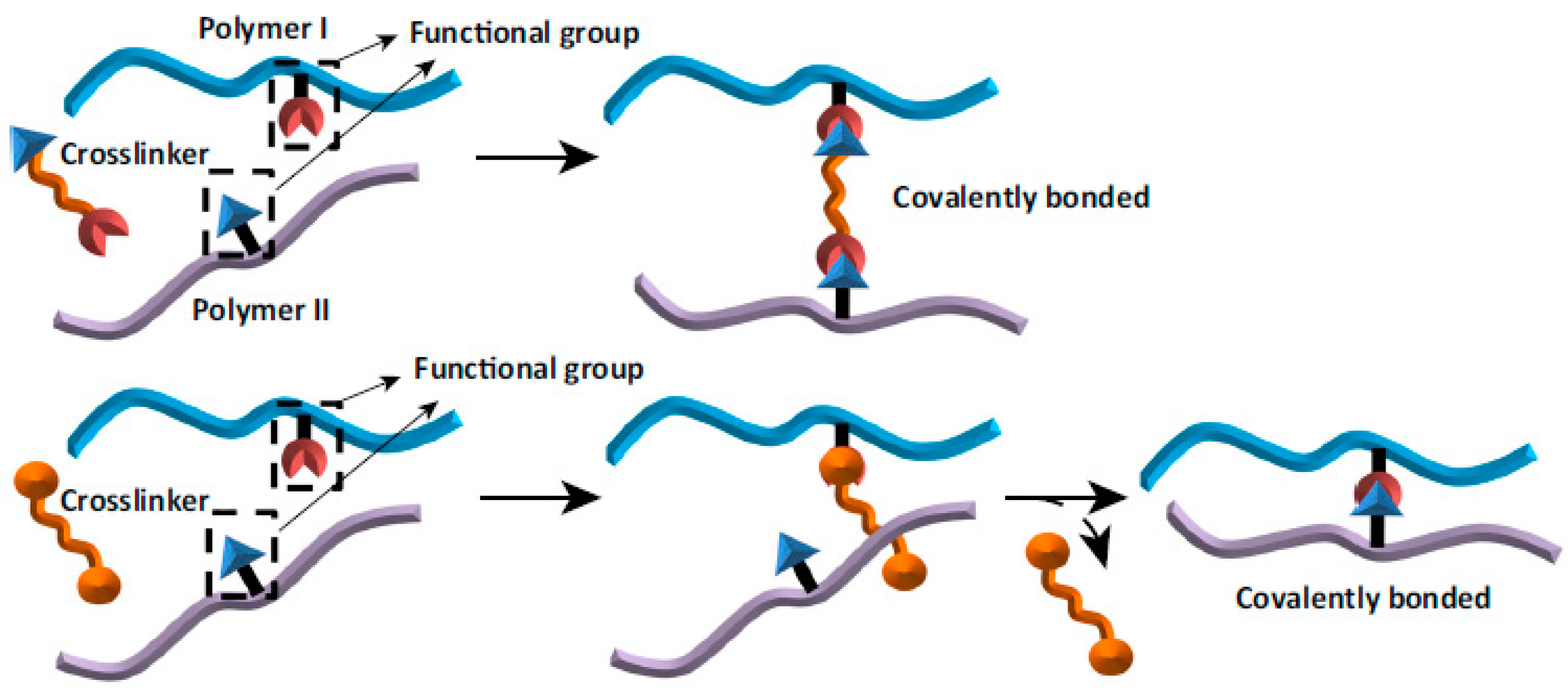

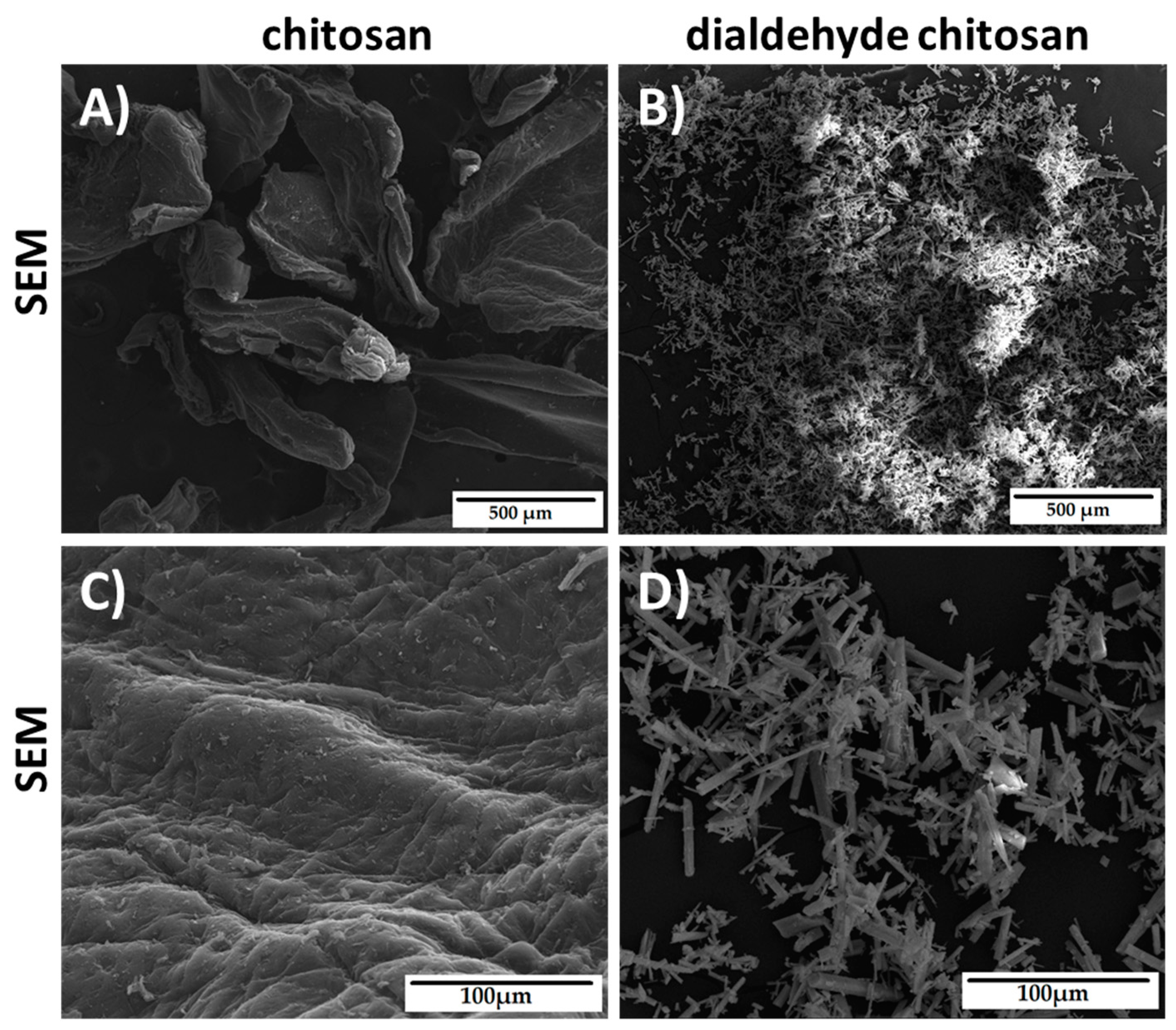


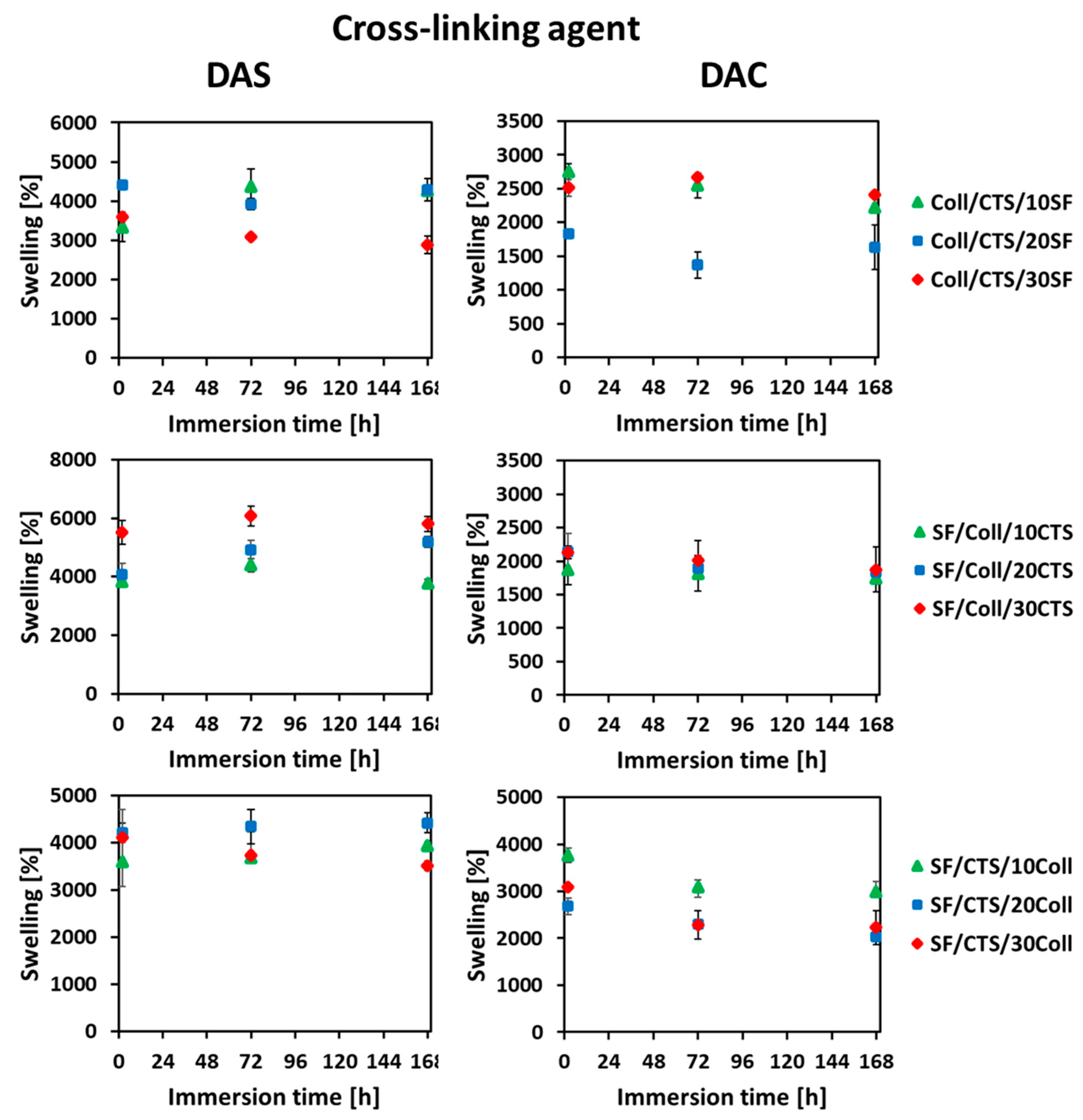
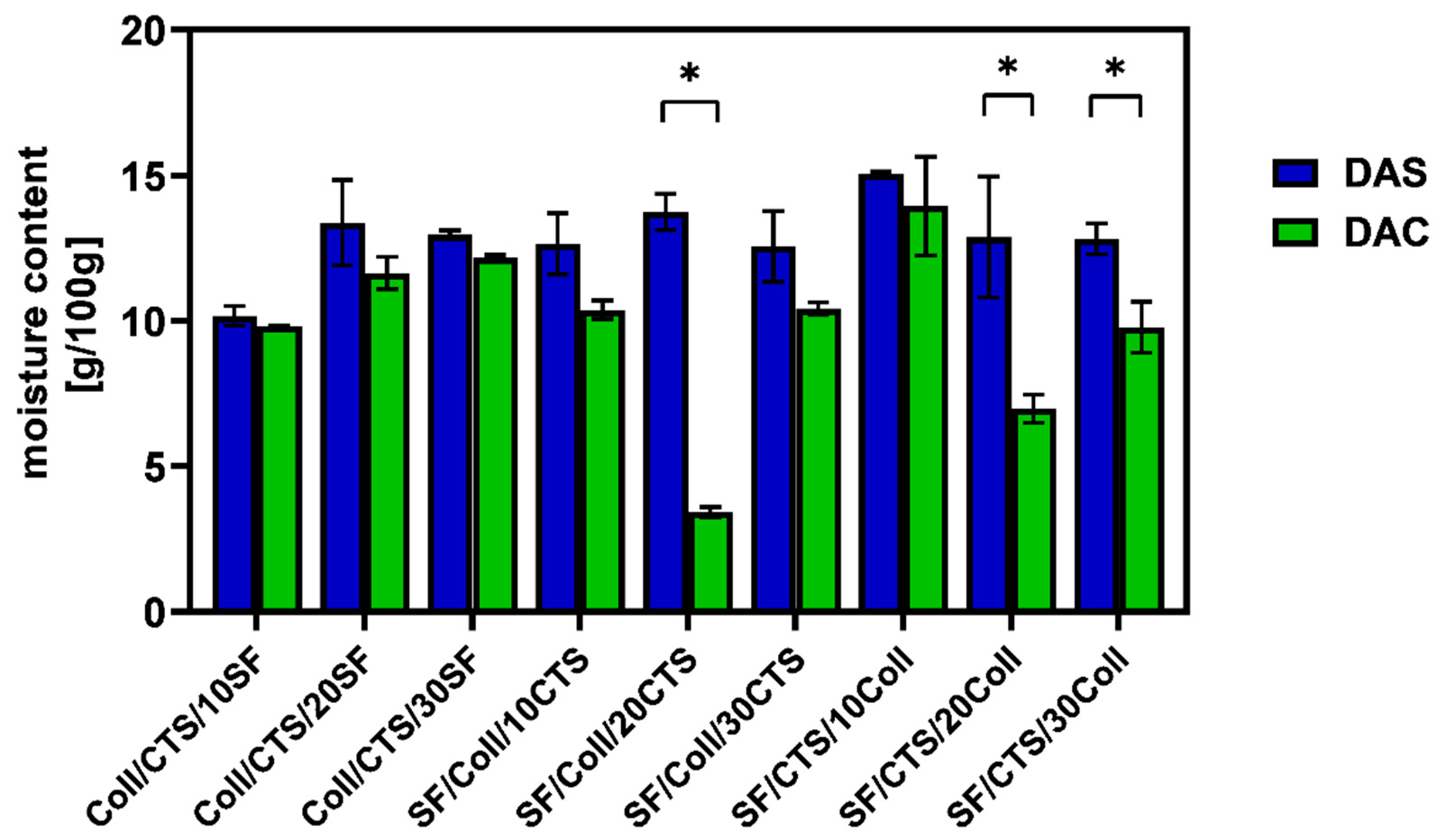

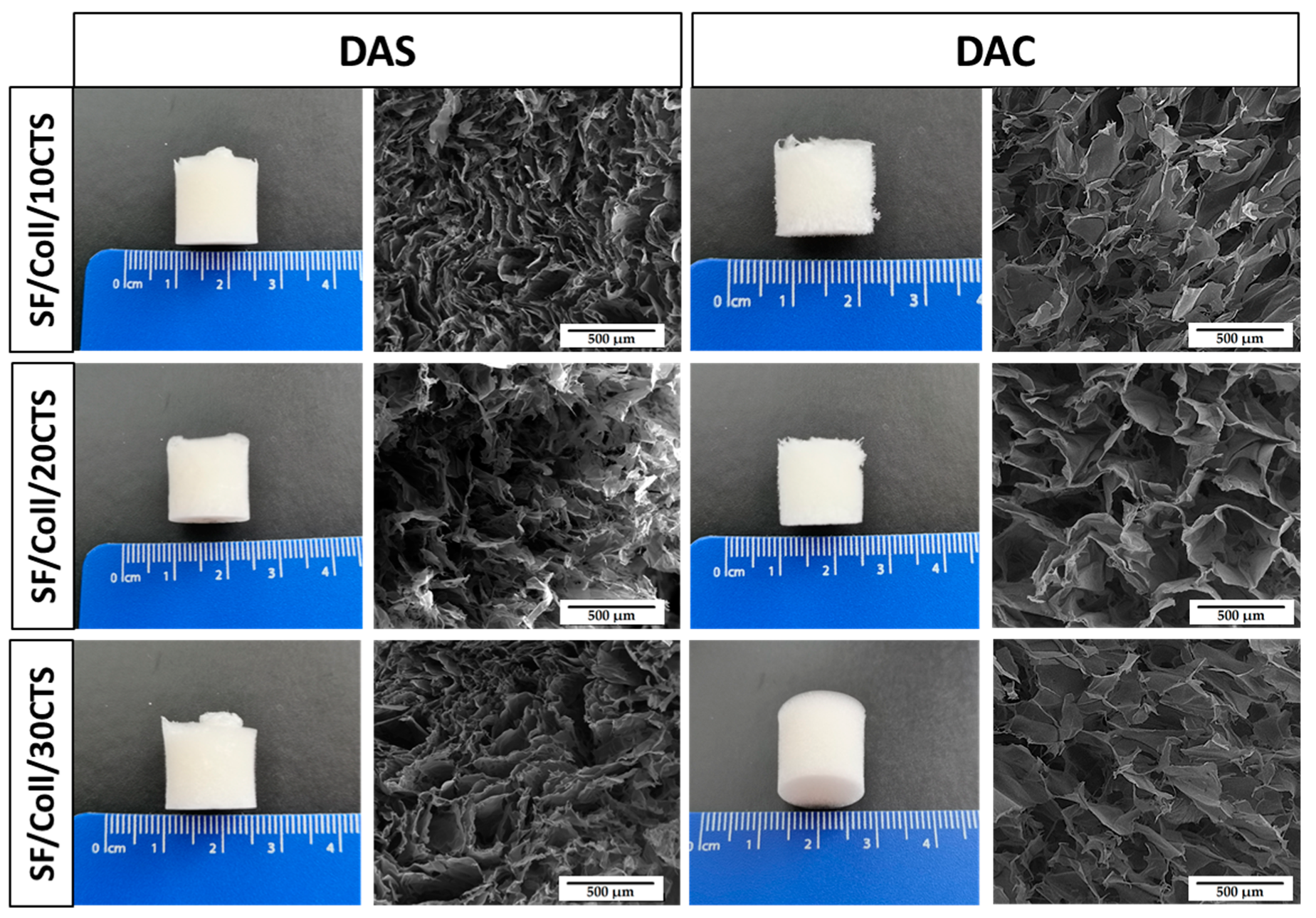
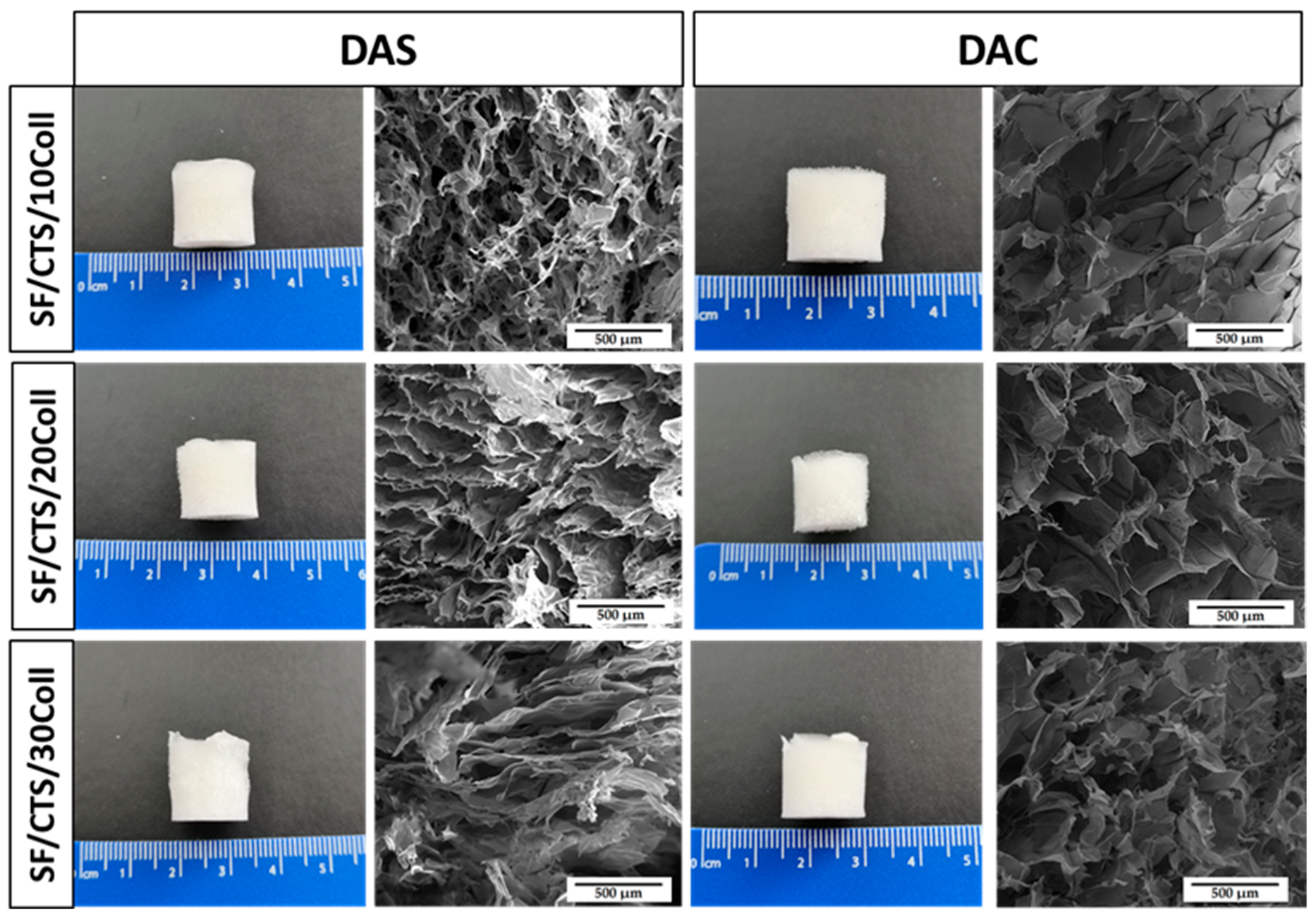
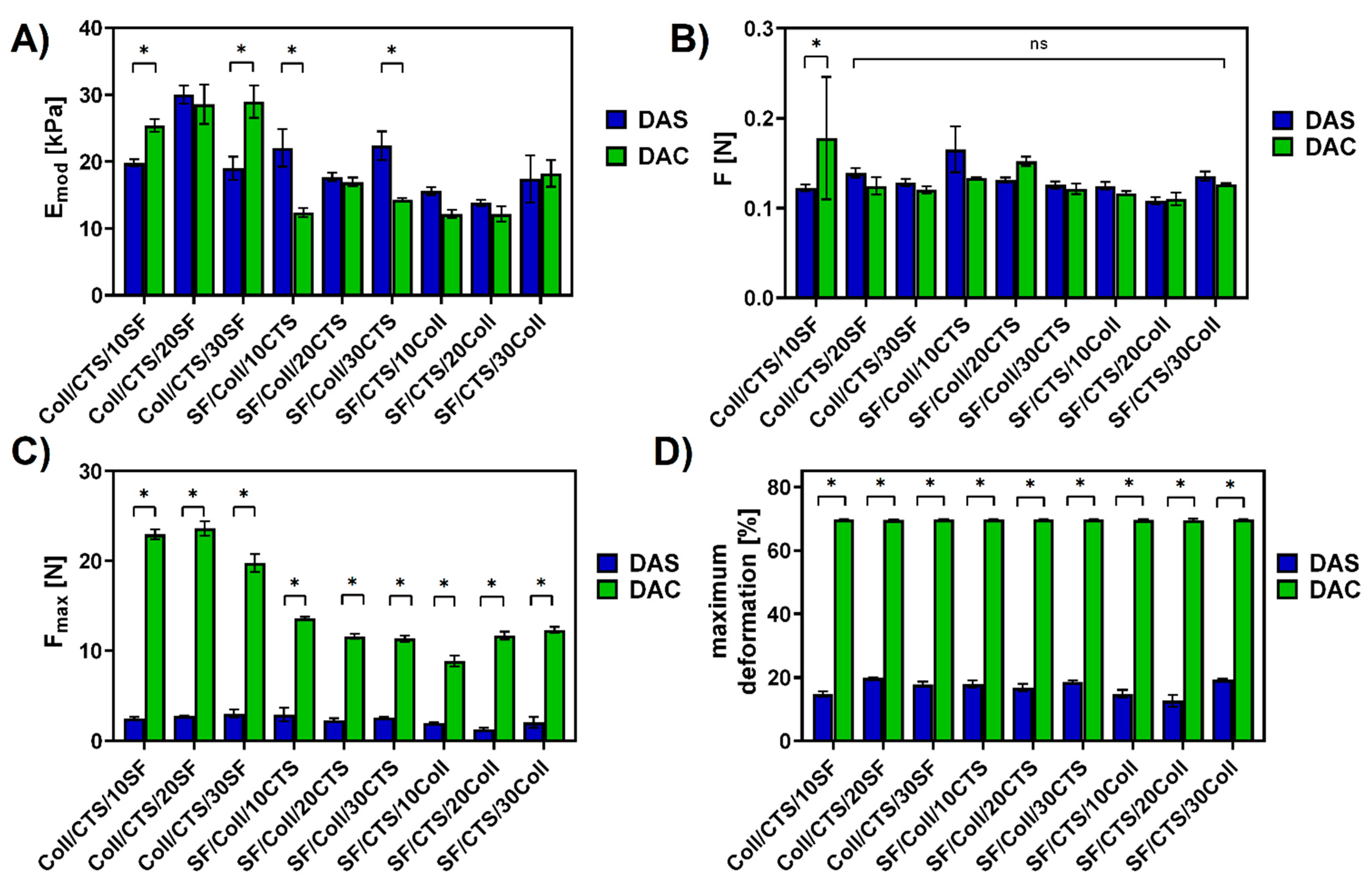
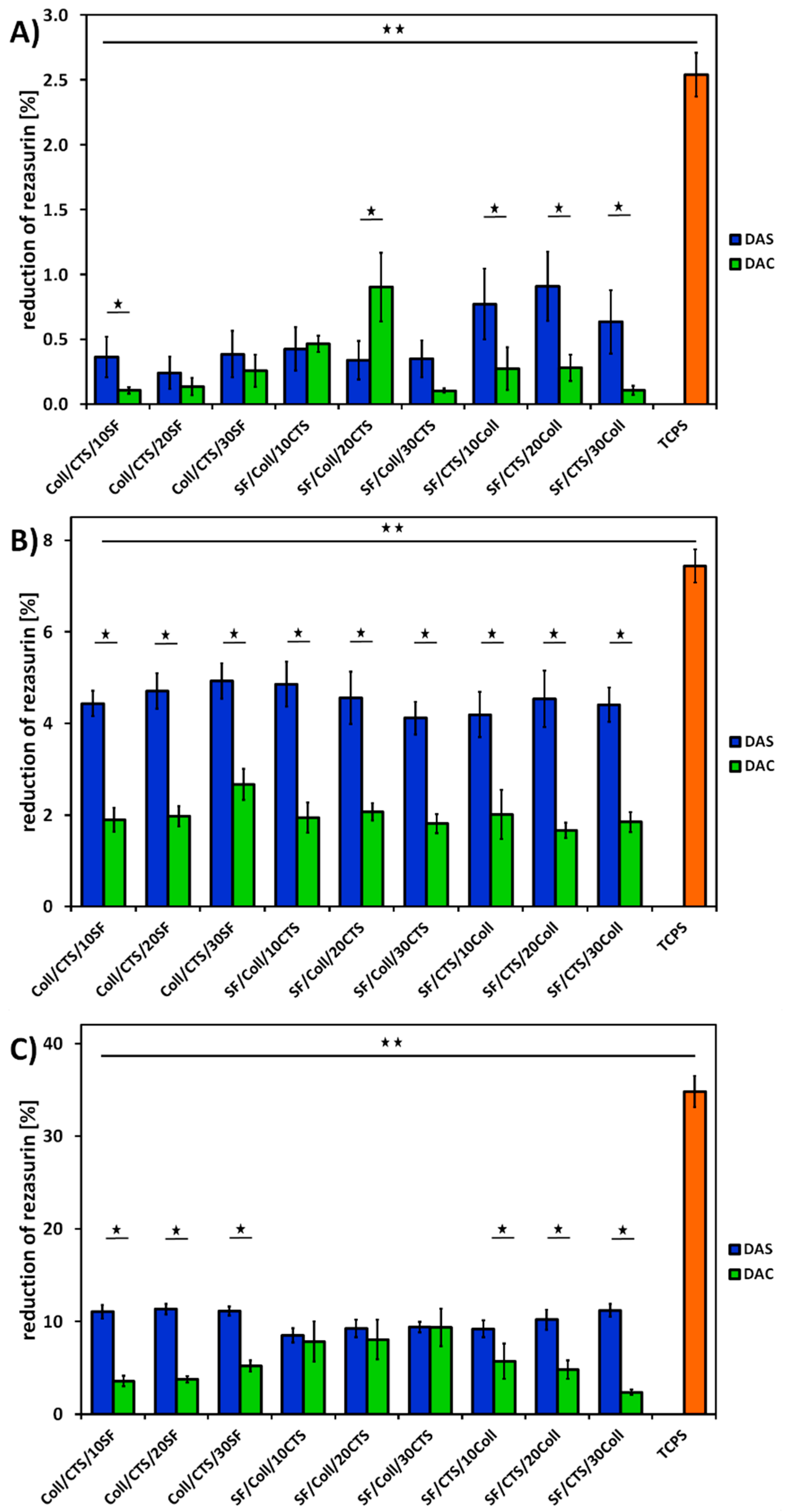

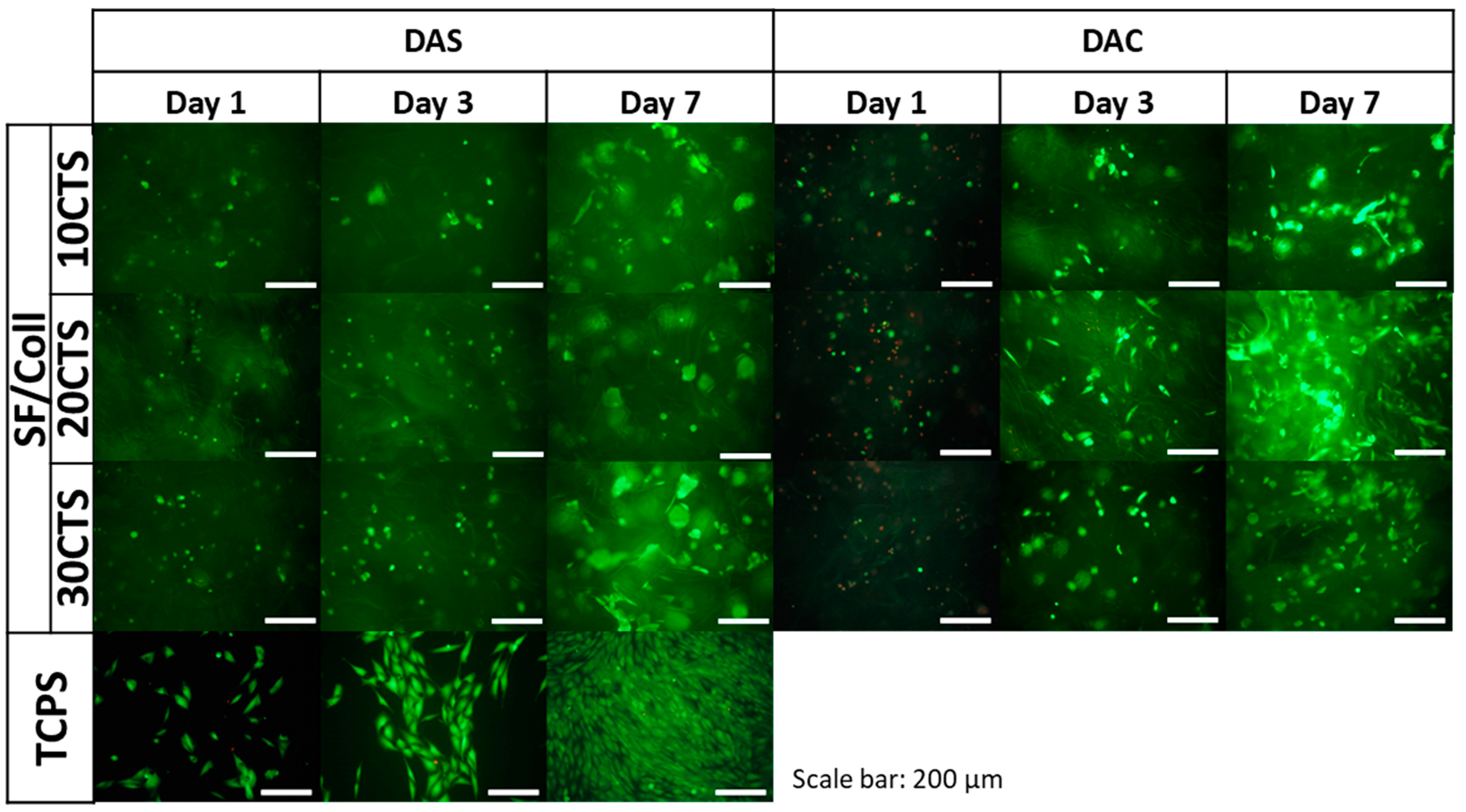
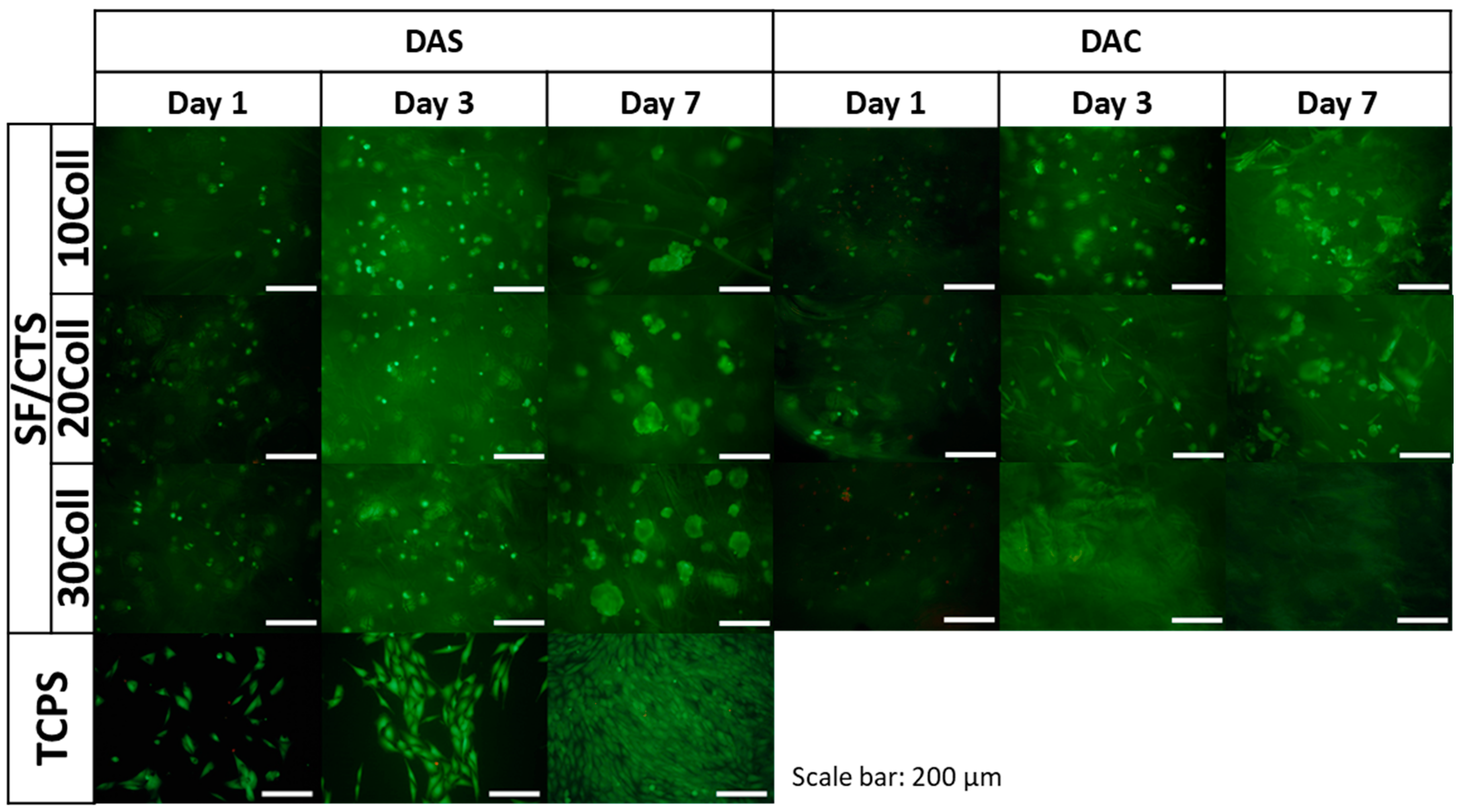

| m [g] | C1 [mol/dm3] | V1 [dm3] | C2 [mol/dm3] | V2 [dm3] | ALD | ALD [%] | |
|---|---|---|---|---|---|---|---|
| sample 1 | 0.1008 | 0.2247 | 0.00890 | 0.2185 | 0.0075 | 0.573 | 57.3 |
| sample 2 | 0.1021 | 0.2247 | 0.00895 | 0.2185 | 0.0075 | 0.583 | 58.3 |
| sample 3 | 0.1020 | 0.2247 | 0.00890 | 0.2185 | 0.0075 | 0.566 | 56.6 |
| Sample | Amide A | C = N | Amide I | Amide II | C–N | Amide III | C–O | |
|---|---|---|---|---|---|---|---|---|
| Coll/CTS/10SF | DAS | 3326 | 1659 | - | 1552 | 1381 | 1241 | 1077 |
| DAC | 3315 | 1658 | 1651 | 1550 | 1385 | 1241 | 1076 | |
| Coll/CTS/20SF | DAS | 3326 | 1657 | 1652 | 1552 | 1381 | 1241 | 1077 |
| DAC | 3296 | 1656 | 1648 | 1540 | 1386 | 1241 | 1076 | |
| Coll/CTS/30SF | DAS | 3307 | 1657 | 1652 | 1549 | 1380 | 1241 | 1077 |
| DAC | 3296 | 1656 | 1651 | 1540 | 1386 | 1241 | 1073 | |
| SF/Coll/10CTS | DAS | 3304 | 1657 | 1650 | 1552 | 1387 | 1240 | 1080 |
| DAC | 3307 | 1659 | 1650 | 1550 | 1386 | 1241 | 1077 | |
| SF/Coll/20CTS | DAS | 3324 | 1659 | - | 1555 | 1380 | 1241 | 1077 |
| DAC | 3399 | 1657 | 1650 | 1544 | 1380 | 1241 | 1076 | |
| SF/Coll/30CTS | DAS | 3319 | 1658 | 1651 | 1552 | 1386 | 1240 | 1079 |
| DAC | 3317 | 1658 | 1650 | 1543 | 1386 | 1240 | 1074 | |
| SF/CTS/10Coll | DAS | 3298 | 1657 | 1652 | 1537 | 1379 | 1246 | 1070 |
| DAC | 3305 | 1657 | 1648 | 1543 | 1386 | 1243 | 1076 | |
| SF/CTS/20Coll | DAS | 3289 | 1655 | 1639 | 1532 | 1379 | 1245 | 1075 |
| DAC | 3317 | 1659 | 1650 | 1543 | 1386 | 1241 | 1075 | |
| SF/CTS/30Coll | DAS | 3304 | 1657 | 1652 | 1544 | 1381 | 1242 | 1076 |
| DAC | 3307 | 1659 | 1651 | 1544 | 1386 | 1242 | 1077 |
| Sample | Porosity [%] | Density [mg/cm3] | ||
|---|---|---|---|---|
| DAS | DAC | DAS | DAC | |
| Coll/CTS/10SF | 91.9 ± 4.5 | 93.7 ± 2.0 | 16.3 ± 2.0 | 15.2 ± 0.1 |
| Coll/CTS/20SF | 92.2 ± 1.4 | 91.0 ± 4.4 | 16.3 ± 0.2 | 14.8 ± 1.1 |
| Coll/CTS/30SF | 86.7 ± 1.0 | 86.0 ± 2.7 | 21.8 ± 2.4 | 14.6 ± 0.7 |
| SF/Coll/10CTS | 88.0 ± 3.8 | 94.2 ± 1.3 | 19.0 ± 2.1 | 16.5 ± 0.7 |
| SF/Coll/20CTS | 86.3 ± 3.4 | 92.6 ± 1.4 | 16.6 ± 1.9 | 12.3 ± 1.5 |
| SF/Coll/30CTS | 89.1 ± 3.3 | 90.0 ± 0.1 | 16.0 ± 1.5 | 11.1 ± 0.3 |
| SF/CTS/10Coll | 88.0 ± 0.4 | 88.0 ± 3.7 | 11.3 ± 1.1 | 15.3 ± 2.0 |
| SF/CTS/20Coll | 83.8 ± 1.0 | 87.8 ± 0.8 | 15.3 ± 0.2 | 17.4 ± 1.5 |
| SF/CTS/30Coll | 87.9 ± 0.1 | 87.9 ± 3.9 | 20.3 ± 0.2 | 27.5 ± 2.3 |
| Sample | Residue [%] T = 600 °C | |
|---|---|---|
| DAS | DAC | |
| Coll/CTS/10SF | 30.48 | 37.89 |
| Coll/CTS/20SF | 25.59 | 41.82 |
| Coll/CTS/30SF | 26.00 | 37.29 |
| SF/Coll/10CTS | 25.22 | 30.08 |
| SF/Coll/20CTS | 27.44 | 35.79 |
| SF/Coll/30CTS | 25.76 | 32.75 |
| SF/CTS/10Coll | 32.53 | 34.21 |
| SF/CTS/20Coll | 25.86 | 33.62 |
| SF/CTS/30Coll | 26.62 | 35.36 |
Publisher’s Note: MDPI stays neutral with regard to jurisdictional claims in published maps and institutional affiliations. |
© 2021 by the authors. Licensee MDPI, Basel, Switzerland. This article is an open access article distributed under the terms and conditions of the Creative Commons Attribution (CC BY) license (http://creativecommons.org/licenses/by/4.0/).
Share and Cite
Grabska-Zielińska, S.; Sionkowska, A.; Olewnik-Kruszkowska, E.; Reczyńska, K.; Pamuła, E. Is Dialdehyde Chitosan a Good Substance to Modify Physicochemical Properties of Biopolymeric Materials? Int. J. Mol. Sci. 2021, 22, 3391. https://doi.org/10.3390/ijms22073391
Grabska-Zielińska S, Sionkowska A, Olewnik-Kruszkowska E, Reczyńska K, Pamuła E. Is Dialdehyde Chitosan a Good Substance to Modify Physicochemical Properties of Biopolymeric Materials? International Journal of Molecular Sciences. 2021; 22(7):3391. https://doi.org/10.3390/ijms22073391
Chicago/Turabian StyleGrabska-Zielińska, Sylwia, Alina Sionkowska, Ewa Olewnik-Kruszkowska, Katarzyna Reczyńska, and Elżbieta Pamuła. 2021. "Is Dialdehyde Chitosan a Good Substance to Modify Physicochemical Properties of Biopolymeric Materials?" International Journal of Molecular Sciences 22, no. 7: 3391. https://doi.org/10.3390/ijms22073391
APA StyleGrabska-Zielińska, S., Sionkowska, A., Olewnik-Kruszkowska, E., Reczyńska, K., & Pamuła, E. (2021). Is Dialdehyde Chitosan a Good Substance to Modify Physicochemical Properties of Biopolymeric Materials? International Journal of Molecular Sciences, 22(7), 3391. https://doi.org/10.3390/ijms22073391









